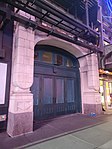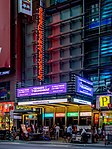Hotel Carter (Manhattan)

The Hotel Carter was a hotel located near Times Square in Manhattan, New York City. The building is 24 stories tall, and at its opening, had 1,000 rooms, but was later downsized to 700 rooms. Opened in 1930 as the Dixie Hotel, it originally extended from 43rd Street to 42nd Street, although the wing abutting 42nd Street has since been demolished. The hotel has changed ownership numerous times throughout its history. In October 1976, it was renamed the Hotel Carter in an attempt to rehabilitate its image. The hotel closed and was offered for sale in 2014. While it was operating, the Hotel Carter gained a negative reputation due to the crimes that took place there, as well as its general uncleanliness. At least nine deaths have occurred in the hotel, including four suicides and four murders. In addition, the Hotel Carter had previously been cited as being among America's dirtiest hotels, both by the media and via visitor reviews.
Excerpt from the Wikipedia article Hotel Carter (Manhattan) (License: CC BY-SA 3.0, Authors, Images).Hotel Carter (Manhattan)
West 43rd Street, New York Manhattan
Geographical coordinates (GPS) Address Nearby Places Show on map
Geographical coordinates (GPS)
| Latitude | Longitude |
|---|---|
| N 40.757305555556 ° | E -73.988333333333 ° |
Address
West 43rd Street 252
10036 New York, Manhattan
New York, United States
Open on Google Maps










